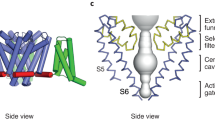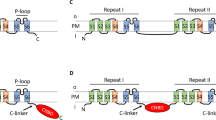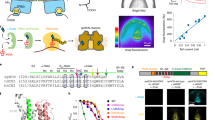Abstract
All living organisms use ion channels to regulate the transport of ions across cellular membranes1. Certain ion channels are classed as voltage-dependent because they have a voltage-sensing structure that induces their pores to open in response to changes in the cell membrane voltage. Until recently, the voltage-dependent K+, Ca2+ and Na+ channels were regarded as a unique development of eukaryotic cells, adapted to accomplish specialized electrical signalling, as exemplified in neurons. Here we present the functional characterization of a voltage-dependent K+ (KV) channel from a hyperthermophilic archaebacterium from an oceanic thermal vent. This channel possesses all the functional attributes of classical neuronal KV channels. The conservation of function reflects structural conservation in the voltage sensor as revealed by specific, high-affinity interactions with tarantula venom toxins, which evolved to inhibit eukaryotic KV channels.
This is a preview of subscription content, access via your institution
Access options
Subscribe to this journal
Receive 51 print issues and online access
$199.00 per year
only $3.90 per issue
Buy this article
- Purchase on Springer Link
- Instant access to full article PDF
Prices may be subject to local taxes which are calculated during checkout




Similar content being viewed by others
References
Hille, B. Ion Channels of Excitable Membranes (Sinauer, Sunderland, Massachusetts, 2001)
Ren, D. et al. A prokaryotic voltage-gated sodium channel. Science 294, 2372–2375 (2001)
Heginbotham, L., Lu, Z., Abramson, T. & MacKinnon, R. Mutations in the K+ channel signature sequence. Biophys. J. 66, 1061–1067 (1994)
Jiang, Y. et al. The open pore conformation of potassium channels. Nature 417, 523–526 (2002)
Sigworth, F. J. Voltage gating of ion channels. Q. Rev. Biophys. 27, 1–40 (1994)
Bezanilla, F. The voltage sensor in voltage-dependent ion channels. Physiol. Rev. 80, 555–592 (2000)
MacKinnon, R., Cohen, S. L., Kuo, A., Lee, A. & Chait, B. T. Structural conservation in prokaryotic and eukaryotic potassium channels. Science 280, 106–109 (1998)
Miller, C., Moczydlowski, E., Latorre, R. & Phillips, M. Charybdotoxin, a protein inhibitor of single Ca2+-activated K+ channels from mammalian skeletal muscle. Nature 313, 316–318 (1985)
MacKinnon, R. & Miller, C. Mechanism of charybdotoxin block of the high-conductance, Ca2+-activated K+ channel. J. Gen. Physiol. 91, 335–349 (1988)
Garcia, M. L., Garcia-Calvo, M., Hidalgo, P., Lee, A. & MacKinnon, R. Purification and characterization of three inhibitors of voltage-dependent K+ channels from Leiurus quinquestriatus var. hebraeus venom. Biochemistry 33, 6834–6839 (1994)
Goldstein, S. A., Pheasant, D. J. & Miller, C. The charybdotoxin receptor of a Shaker K+ channel: peptide and channel residues mediating molecular recognition. Neuron 12, 1377–1388 (1994)
Schoppa, N. E., McCormack, K., Tanouye, M. A. & Sigworth, F. J. The size of gating charge in wild-type and mutant Shaker potassium channels. Science 255, 1712–1715 (1992)
Aggarwal, S. K. & MacKinnon, R. Contribution of the S4 segment to gating charge in the Shaker K+ channel. Neuron 16, 1169–1177 (1996)
Seoh, S. A., Sigg, D., Papazian, D. M. & Bezanilla, F. Voltage-sensing residues in the S2 and S4 segments of the Shaker K + channel. Neuron 16, 1159–1167 (1996)
Yifrach, O. & MacKinnon, R. Energetics of pore opening in a voltage-gated K(+ ) channel. Cell 111, 231–239 (2002)
Zagotta, W. N., Hoshi, T. & Aldrich, R. W. Shaker potassium channel gating. III: Evaluation of kinetic models for activation. J. Gen. Physiol. 103, 321–362 (1994)
Schoppa, N. E. & Sigworth, F. J. Activation of Shaker potassium channels. III. An activation gating model for wild-type and V2 mutant channels. J. Gen. Physiol 111, 313–342 (1998)
Armstrong, C. M. Interaction of tetraethylammonium ion derivatives with the potassium channels of giant axons. J. Gen. Physiol. 58, 413–437 (1971)
Hoshi, T., Zagotta, W. N. & Aldrich, R. W. Biophysical and molecular mechanisms of Shaker potassium channel inactivation. Science 250, 533–538 (1990)
Hoshi, T., Zagotta, W. N. & Aldrich, R. W. Two types of inactivation in Shaker K+ channels: effects of alterations in the carboxy-terminal region. Neuron 7, 547–556 (1991)
Swartz, K. J. & MacKinnon, R. Hanatoxin modifies the gating of a voltage-dependent K+ channel through multiple binding sites. Neuron 18, 665–673 (1997)
Swartz, K. J. & MacKinnon, R. Mapping the receptor site for hanatoxin, a gating modifier of voltage-dependent K+ channels. Neuron 18, 675–682 (1997)
McDonough, S. I., Lampe, R. A., Keith, R. A. & Bean, B. P. Voltage-dependent inhibition of N- and P-type calcium channels by the peptide toxin omega-grammotoxin-SIA. Mol. Pharmacol. 52, 1095–1104 (1997)
Li-Smerin, Y. & Swartz, K. J. Gating modifier toxins reveal a conserved structural motif in voltage-gated Ca2+ and K+ channels. Proc. Natl Acad. Sci. USA 95, 8585–8589 (1998)
Middleton, R. E. et al. Two tarantula peptides inhibit activation of multiple sodium channels. Biochemistry 41, 14734–14747 (2002)
Heginbotham, L., LeMasurier, M., Kolmakova-Partensky, L. & Miller, C. Single streptomyces lividans K+ channels. Functional asymmetries and sidedness of proton activation. J. Gen. Physiol. 114, 551–560 (1999)
Park, C. S., Hausdorff, S. F. & Miller, C. Design, synthesis, and functional expression of a gene for charybdotoxin, a peptide blocker of K + channels. Proc. Natl Acad. Sci. USA 88, 2046–2050 (1991)
Gill, S. C. & von Hippel, P. H. Calculation of protein extinction coefficients from amino acid sequence data. Anal. Biochem. 182, 319–326 (1989)
Diochot, S., Drici, M. D., Moinier, D., Fink, M. & Lazdunski, M. Effects of phrixotoxins on the Kv4 family of potassium channels and implications for the role of Ito1 in cardiac electrogenesis. Br. J. Pharmacol. 126, 251–263 (1999)
Escoubas, P., Diochot, S., Celerier, M. L., Nakajima, T. & Lazdunski, M. Novel tarantula toxins for subtypes of voltage-dependent potassium channels in the Kv2 and Kv4 subfamilies. Mol. Pharmacol. 62, 48–57 (2002)
Acknowledgements
We thank M. Trester-Zedlitz for assistance with mass spectrometry and W. Chin for assistance in manuscript preparation. Protein sequence was done at the Rockefeller University Protein/DNA Technology Center (supported by NIH shared instrumentation grants, the US Army and Navy). This research was supported by an NIH grant. V.R. is supported by a NSF graduate student research fellowship and R.M. is an Investigator in the Howard Hughes Medical Institute.
Author information
Authors and Affiliations
Corresponding author
Ethics declarations
Competing interests
The authors declare that they have no competing financial interests.
Rights and permissions
About this article
Cite this article
Ruta, V., Jiang, Y., Lee, A. et al. Functional analysis of an archaebacterial voltage-dependent K+ channel. Nature 422, 180–185 (2003). https://doi.org/10.1038/nature01473
Received:
Accepted:
Published:
Issue Date:
DOI: https://doi.org/10.1038/nature01473
This article is cited by
-
Investigation of lipid/protein interactions in trifluoroethanol-water mixtures proposes the strategy for the refolding of helical transmembrane domains
Journal of Biomolecular NMR (2023)
-
Molecular Interactions between Tarantula Toxins and Low-Voltage-Activated Calcium Channels
Scientific Reports (2016)
-
Cryo-electron microscopy structure of the Slo2.2 Na+-activated K+ channel
Nature (2015)
-
Polymer-based microfluidic device for measuring membrane protein activities
Microfluidics and Nanofluidics (2013)
-
Structure of the Acid-sensing ion channel 1 in complex with the gating modifier Psalmotoxin 1
Nature Communications (2012)
Comments
By submitting a comment you agree to abide by our Terms and Community Guidelines. If you find something abusive or that does not comply with our terms or guidelines please flag it as inappropriate.



